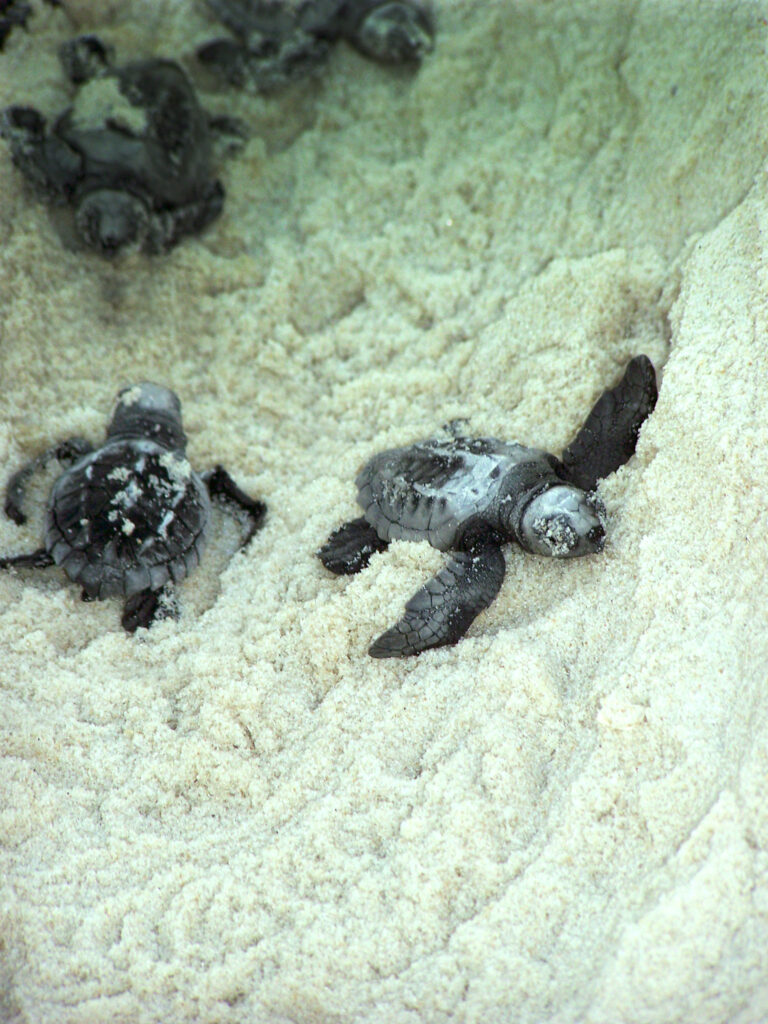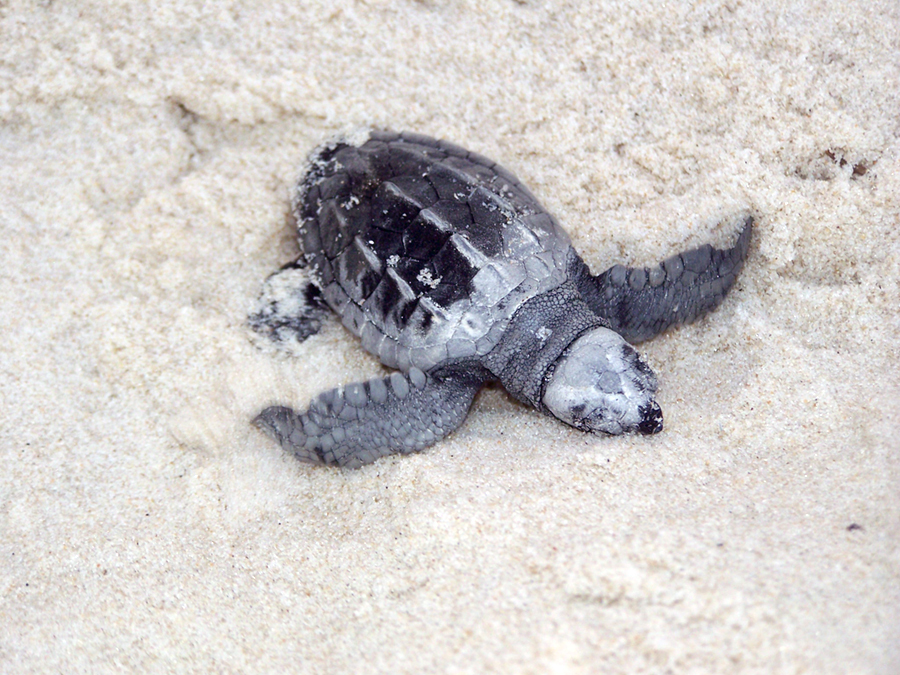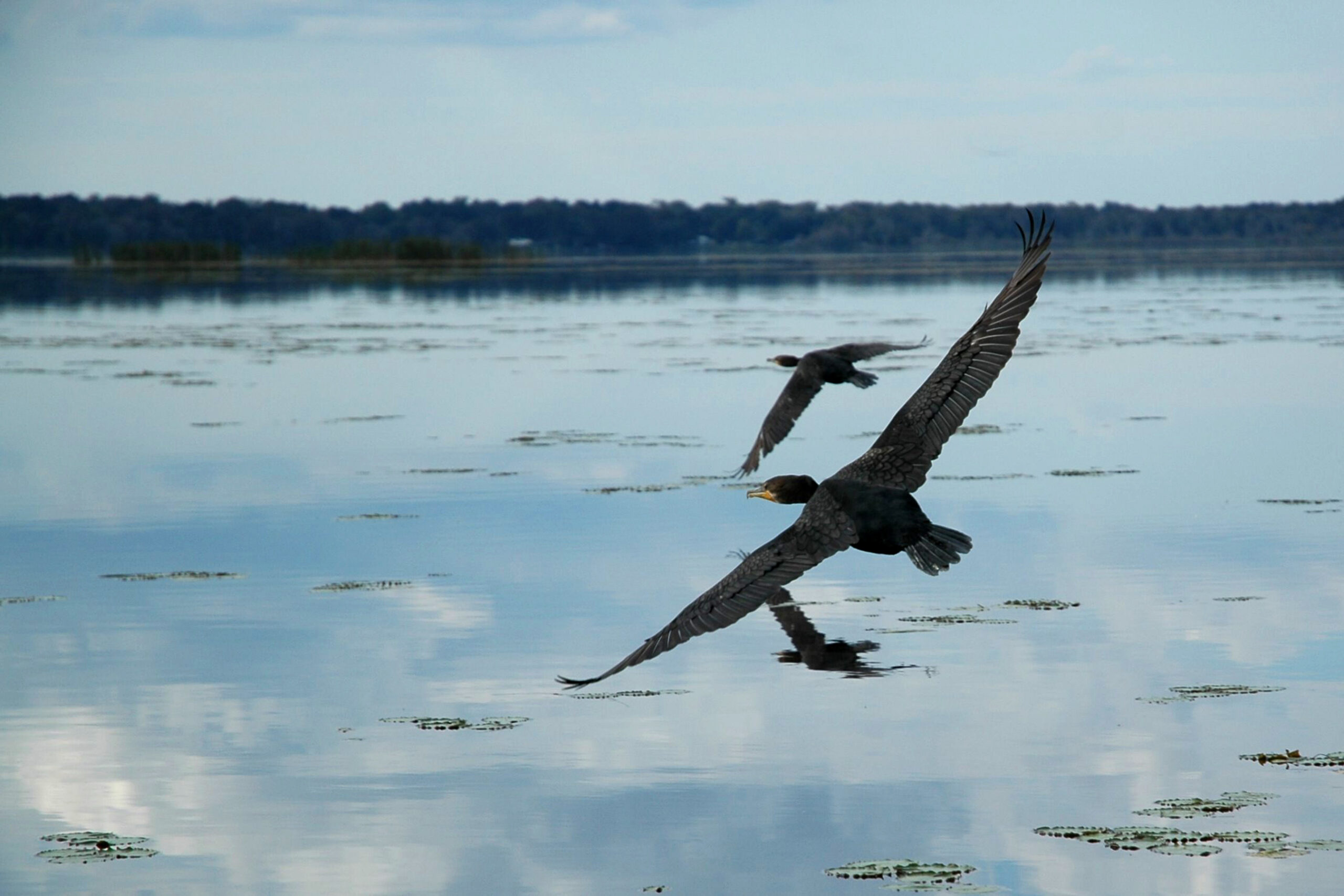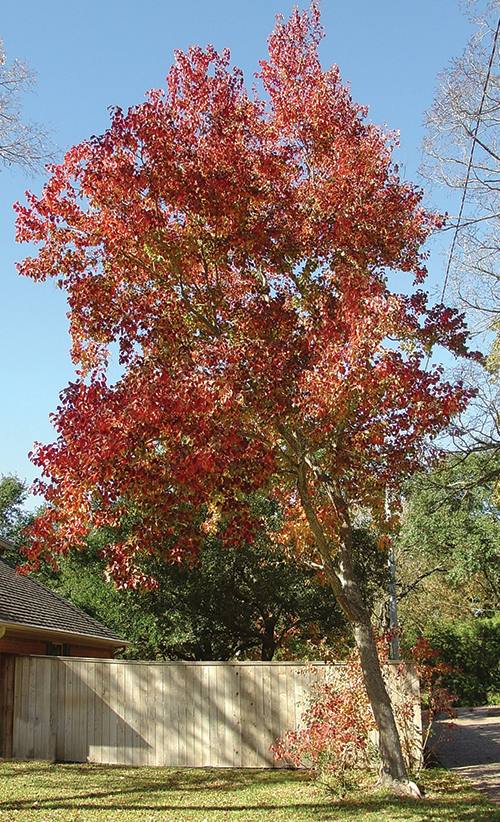During Alabama’s Sea Turtle Nesting Season
By Katie Jackson

While Alabama’s busy summer beach season may have come to an end, fall is actually high season for someparticularly adorable little ones who are busily digging out of the sand and racing into the surf.
These small fry are baby sea turtles (hatchlings) who spent late spring and early summer incubating under the sand and are now breaking out of their leathery shells (a process known as “pipping”) and scrambling to the surface. Once there, the entire clutch, which may number 80-150 babies, will make a synchronized dash for the sea, a clamber of cuteness referred to as a “boil.”
The race from nest to water — which typically occurs at night for Loggerheads, the most common nesting species on Alabama beaches — is an especially vulnerable time for hatchlings who must navigate past an array of predators such as ghost crabs, shore birds and small mammals as they instinctively move toward moonlight reflecting off the sea’s surface.
However, this innate and age-old ritual is often disrupted by artificial light emanating from beachside houses, condos and businesses that draws the babies inland rather than toward the relative safety of the sea. The lights, which also affect female turtles as they come ashore in May through August to lay their eggs, are considered a primary reason that Alabama’s four most common sea turtle species — Loggerhead, Kemp’s Ridley, Green and Leatherback — are listed as threatened or endangered under the federal Endangered Species Act.
Fortunately, these turtles have an array of human allies such as those involved with the Alabama Coastal Foundation and its Share the Beach program. This coalition of volunteers works to find and protect sea turtle nests and their emerging hatchlings, educate the public about these ancient and amazing creatures and help mitigate the detrimental effects of artificial light pollution and other threats to sea turtle populations.
The turtles are also lucky that several pockets of protected habitat, where light pollution and other human-related pressures are limited, exist along Alabama’s nearly 60 miles of Gulf-fronting beaches.
“You tend to see more nests where it’s darker,” says Amy Hunter, Deepwater Horizon Restoration Coordinator for the Alabama Department of Conservation and Natural Resources. “Going out toward Fort Morgan along the Bon Secour National Wildlife Refuge is a really dark area, so we get a lot of Loggerhead nests there and this year we have had several Kemp’s nests as well.”
A friendly habitat
Loggerheads and occasionally Kemp’s Ridley are also finding their way to Dauphin Island’s West End Nature Preserve, a 10-mile-long spit of beach and dune habitat purchased from private owners in 2021. That purchase was made using bird restoration funds allocated to Alabama through the Natural Resource Damage Assessment process, associated with the 2015 settlement after the 2010 Deepwater Horizon Oil Spill.
According to Dauphin Island Mayor Jeff Collier, the 838-acre preserve provides “a rich and vibrant habitat for a variety of animals” including sea turtles and the snowy plover, a migratory shorebird considered a “species of concern” that is increasingly nesting there.
“It’s a great success story that we were able to use oil spill money to purchase the land, which will never be developed, for conservation,” Hunter says.
After its purchase by NRDA, ownership of the property was transferred to the town of Dauphin Island, which administers a comprehensive conservation management plan to ensure the land remains healthy and productive for animals and humans alike.
“We want people to utilize that stretch of island but do it in the most responsible and respectful way,” Collier says.
To help ensure that happens, city personnel who serve as “beach ambassadors” help monitor wildlife activity and keep the preserve clean while also educating beachgoers about ways they can enjoy the beach without harming the environment or nature.
In addition to the city’s staff, volunteers with the island’s Share the Beach program patrol the West End and other beaches on the island every morning during sea turtle nesting season (typically May through August looking for and marking sea turtle nests and on through the end of October to monitor hatchings). As of early August, volunteers had found 19 nests on Dauphin Island, most of which were Loggerhead turtles.
Summer and fall beachgoers can also be good stewards of the beaches and dunes by following such guidelines as staying away from nesting areas; removing trash, beach chairs and equipment from the beach and filling in holes each night; and cutting off outdoor lights and using turtle-friendly flashlights at night. (See more information in sidebar.)
Collier noted that local real estate companies have joined in the educational effort by creating placards and refrigerator magnets that educate renters about sea turtles. “People can still come to the beach. They can still have fun and enjoy themselves, and that’s what we want folks to do.
“I think it’s neat that people can share this wonderful environment with all these creatures. That we can all coexist in that natural environment,” he says.
And if they’re lucky, visitors may even get to witness one of nature’s most endearing and remarkable events as those adorable babies make their mad dash to the sea.

How can you help the nesting turtles?
When staying at the beach, follow these guidelines, from outdooralabama.com:
- Turn off lights visible on nesting beaches or use wildlife-friendly lighting.
- Tint windows that face the beach.
- Close opaque curtains or blinds after dark to cover any windows that are visible from the beach.
- Do not use flashlights or cell phone lights while walking on the beach at night. If you need lighting,
use a sea turtle-friendly red flashlight, as red, orange or amber lights are less disorienting for sea turtles. - The Florida Fish and Wildlife Conservation Commission has sea turtle lighting guidelines: myfwc.com/media/18511/seaturtle-lightingguidelines.pdf




